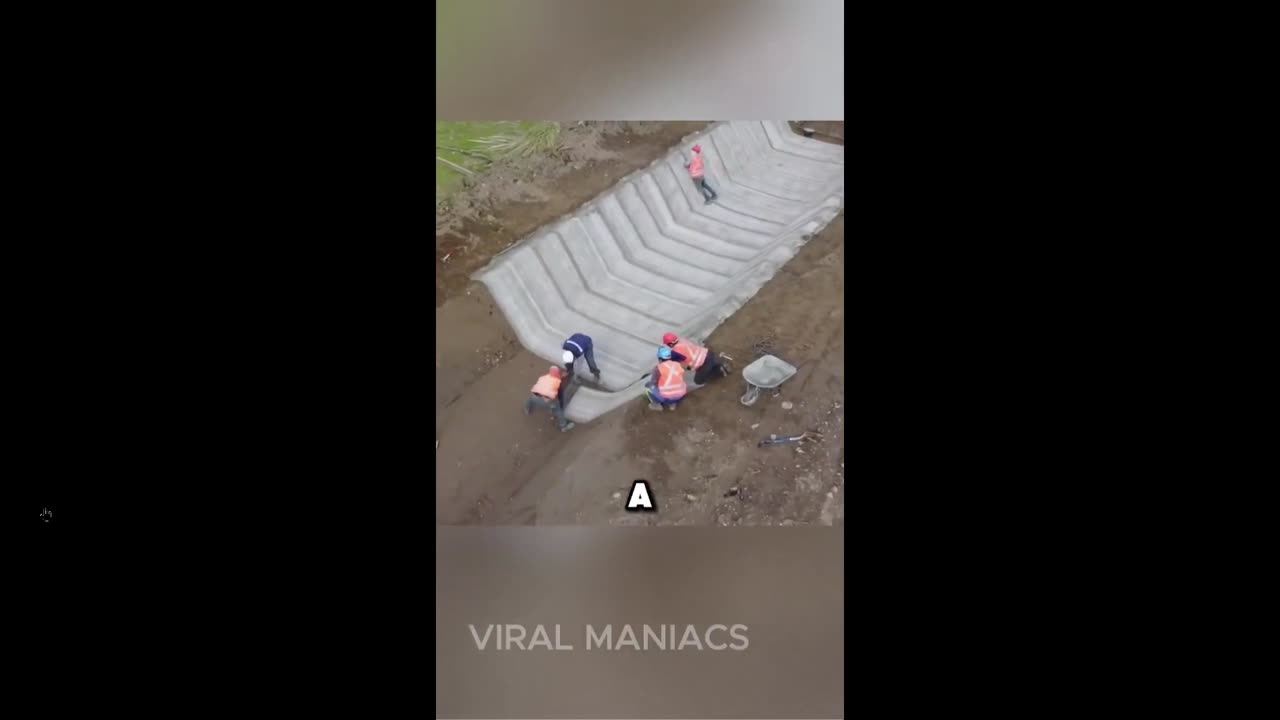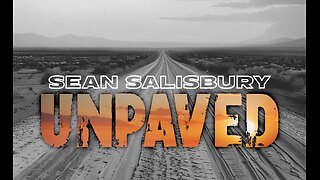Premium Only Content

This is a cool invention - Fast, inexpensive and a million uses - Cement Blankets
It’s soft like fabric - until you add water - then it turns into solid concrete.
It uses 90% less material, cuts construction time by 60%, and 3 workers can lay 200 m² per hour.
Whoever made this deserves a Nobel Prize in "Why Didn’t We Think of This Sooner."
Source: Viral Maniacs
a product commonly known as Concrete Canvas® (CC), a flexible geosynthetic material impregnated with a specialized cement mix. The post highlights its innovative nature, and the attached video (from Viral Maniacs) demonstrates workers unrolling large rolls of the fabric-like material onto sloped surfaces, such as ditches or embankments, securing it in place, and then spraying it with water using hoses. As the narration explains, it's soft and pliable when dry (resembling a blanket) but hardens into a solid, fiber-reinforced concrete layer once hydrated. The video emphasizes its ease of transport, flexibility, and rapid deployment, showing various applications like lining irrigation channels, protecting slopes, and creating barriers, with text overlays noting it saves 90% of materials compared to traditional concrete, reduces construction time by 60%, and allows three workers to cover 200 square meters per hour—making it about 10 times faster than conventional methods.What is Concrete Canvas?Concrete Canvas is a Geosynthetic Cementitious Composite Mat (GCCM), essentially "concrete on a roll." It's composed of a three-dimensional synthetic fiber matrix filled with a custom high-early-strength cement blend, backed by a waterproof PVC coating on one side. When dry, it's flexible and can be rolled up for easy transport and storage. Upon adding water (any type, including saline or non-potable), it hydrates and sets, forming a thin, durable, waterproof concrete layer. The fibrous top surface is exposed during installation to ensure proper hardening, while the PVC backing protects against weathering and UV damage.
2 sources
It's manufactured in the UK using bespoke machinery and comes in different variants, such as CC (for general erosion control) and CC Hydro (CCH, which includes an additional impermeable geomembrane liner for containment applications requiring chemical resistance).
Thickness typically ranges from 5mm to 13mm depending on the type (e.g., CCT5 at 5mm, CCT8 at 8mm, CCT13 at 13mm), with weights around 7-19 kg/m².
2 sources
How It Works and InstallationPreparation and Deployment: The material arrives in rolls (e.g., 3.28 ft x 32.8 ft or larger bulk rolls). Workers unroll it over the prepared surface (which should be stable and free of sharp objects), cut it to shape if needed (using snap-off blades or disc cutters while dry), and secure it with pegs or anchors at intervals (e.g., every 2-3 meters, more in windy or sloped areas).
Hydration: Spray with water at a minimum ratio of 1:2 by weight (e.g., at least 6 liters/m² for a 12 kg/m² variant). It can't be over-hydrated, and excess water simply runs off. It sets underwater or in rain, making it suitable for adverse weather.
Setting Time: Working time is 1-2 hours after wetting (adjustable for custom orders in extreme climates). It reaches full strength in 24 hours.
Joining: Overlaps are screwed, sealed, or thermally bonded for watertight seams.
No heavy machinery or mixing is required beyond basic tools, and it conforms to irregular surfaces better than poured concrete.AdvantagesEfficiency: Installs 10x faster than traditional concrete, reducing labor and time costs. Three workers can indeed lay up to 200 m²/hour in ideal conditions.
Material Savings: Uses up to 95% less material by volume, as it's a thin layer rather than thick slabs.
Environmental Benefits: Lower carbon footprint (up to 50% less CO₂ emissions than conventional concrete), low alkaline reserve (below US EPA limits for hazardous materials), and no measurable soluble chromium (VI). It's not classified as an irritant, though standard PPE like gloves and masks is recommended during handling.
Versatility: Easy to transport (rolls fit on trucks or even man-portable for remote areas), flexible before setting, and fire-resistant once hardened.
2 sources
ApplicationsPrimarily used in civil infrastructure, mining, petrochemical, agriculture, and military sectors, it's ideal for areas needing quick, durable surfacing without heavy equipment. Key uses include:Erosion Control: Lining ditches, channels, and culverts to prevent soil washout; protecting slopes and outfalls from water flow.
Weed Suppression and Remediation: Covering contaminated sites or bunds (earthen barriers) to contain spills and inhibit plant growth.
Containment: Lining lagoons, tanks, or secondary containment areas for chemicals/oil (especially with CCH variant).
Shelter and Protection: Creating rapid-deploy tents or shelters (e.g., military or disaster relief), vent walls in mines, or protective covers for pipes and gabions.
Other: Pond liner protection in landscaping, or even artistic/installation projects.
6 sources
It's not typically for high-traffic roads or structural load-bearing (e.g., no rebar integration), but for surface protection where traditional concrete is overkill or impractical.Durability and Potential DrawbacksConcrete Canvas is BBA-certified (British Board of Agrément) for over 120 years of durability in erosion control applications, with resistance to abrasion, weathering, UV (via PVC backing), and chemicals (in CCH). Once set, it's waterproof, fire-resistant, and can withstand moderate impacts, though its thin profile (half-inch or less) makes it unsuitable for heavy vehicular traffic or extreme loads—it could crack under repeated stress or freeze-thaw cycles in unsupported areas.
This aligns with some skeptical replies in the X thread, where users questioned its longevity (e.g., "half inch thick concrete doesn't seem like it will have much of a useful life" or concerns about floods ripping it up). While it's robust for its intended uses like slope stabilization, it's not a replacement for thick poured concrete in high-wear scenarios. Real-world performance depends on proper installation and site preparation; failures could occur if the underlying soil shifts or if not anchored well.If you're interested in purchasing or specifics for a project, check the official site (concretecanvas.com) or distributors like Ferguson Waterworks or Aquascape for pricing and availability.
Fakebook doesn’t want you reading most sites we link to or any vids we post. Their algorithm hides our pages and humor too as best it can. The way to stick it to Zuckerberg? Sign up for our once-a-day newsletter. Takes 6 seconds. We send out the best – most popular links daily, no spam, plus a splash of honesty even beyond Whatfinger’s homepage…. – CLICK HERE 🛑 - https://www.whatfinger.com/newsletter/
For HOURS of fun – Steve Inman as well as other humor, quick smile clips , more – Whatfinger’s collection – https://choiceclips.whatfinger.com/category/just-interesting/
The News Variable Show of Whatfinger News, with Mal Antoni hosting... All controversial statements by Mr. Antoni are his own opinions. If you don't like them, don't watch. If you are one of those nut cases who watch just to complain, get a life or stick to fake news. We have no time for your BS. America needs patriots that just say it like it is. If you don't like it, too damn bad. Mr. Antoni is now the main editor over at Whatfinger News, the greatest aggregate news site out there - with more news and commentary daily than the next 7 competitors combined. Experience it once and you're hooked https://www.whatfinger.com/
------DISCLAIMER: This show contains opinions of the host and guests and is meant for education and/or entertainment purposes only. News Variable provides information and the sources where it was obtained. Viewer discretion is advised.
-
 LIVE
LIVE
Dr Disrespect
5 hours ago🔴LIVE - DR DISRESPECT - BLACK OPS 7 MULTIPLAYER GAMEPLAY - NEW!
1,711 watching -
 LIVE
LIVE
Dr. Drew
4 hours agoFL First Lady Casey DeSantis: Florida Ending ALL Vaccine Mandates, Including For Schools w/ FL Surgeon General Dr. Joseph Ladapo & Tom Renz – Ask Dr. Drew
1,957 watching -
 1:05:57
1:05:57
Russell Brand
3 hours agoPfizer Agrees $70 Million Deal With Trump As Study Links Covid Vax to CANCER!! - SF644
61K56 -
 48:25
48:25
JULIE GREEN MINISTRIES
1 hour agoLIVE WITH JULE, ERIC TRUMP AND CLAY CLARK
7.7K31 -
 1:04:57
1:04:57
The Quartering
4 hours agoTrump Tricks Democrats Again, Cheerleader Monster, Abortion Clinics Shutdown & More
66.1K17 -
 7:59
7:59
Dr. Nick Zyrowski
1 year agoHow Much Vitamin D Should I Take
2622 -
 1:23:00
1:23:00
Brandon Gentile
1 day agoJames Lavish: The Red Flag Event Sends Us To $1M Bitcoin & $20K Gold
38 -
 1:23:46
1:23:46
Sean Unpaved
4 hours agoOctober Blitz: Wild Card Game 3s, CFB Coaching Chaos, & TNF Fireworks
27.1K4 -
 1:01:36
1:01:36
Dear America
3 hours agoEpisode 2 Graham Allen Show
57.7K52 -
 1:59:01
1:59:01
The Charlie Kirk Show
4 hours agoCancel Netflix? + The Secret Service Disaster + Turning Point Everywhere | Tatum, Cocca, Gaffrey
111K49
